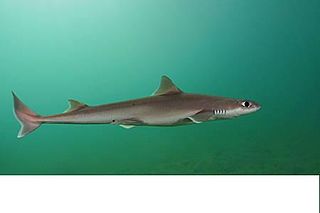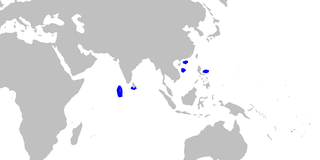
The Squaliformes are an order of sharks that includes about 126 species in seven families.
Squalidae, more commonly known as dogfish, dog sharks, or spiny dogfish, are one of several families of sharks categorized under Squaliformes, making it the second largest order of sharks, numbering 119 species across 7 families. Having earned their name after a group of fishermen reportedly observed the species chasing down smaller fish in dog-like packs, dogfish have slender, streamlined bodies, usually more compact in comparison to other species, and a pointed snout. Dogfish likewise have two dorsal fins, each with smooth spines, but no anal fin, and their skin is generally rough to the touch. As the species reaches adulthood, males usually measure a maximum of 100 cm, while females typically measure 125 cm long. The species therefore exhibits female-dominant sexual dimorphism.
Centrophorus is a genus of squaliform sharks. These deep-water sharks, found in temperate and tropical oceans throughout the world, are characterized by grey or brown bodies, large green eyes, and spines on both dorsal fins. These spines give them their name, from Greek κεντρον, kentron meaning "thorn" and φέρειν, pherein meaning "to bear".

The dumb gulper shark is a rare and endangered deepwater dogfish, found along the east coast of Australia and in isolated spots north and west of New Zealand. It is also known as the dumb shark, Harrison's deep-sea dogfish, or Harrison's dogfish.

The lowfin gulper shark is a large deepwater dogfish in the family Centrophoridae.

The smallfin gulper shark or endeavour dogfish, is a medium-sized deepwater dogfish in the family Centrophoridae.

The leafscale gulper shark is a dogfish of the family Centrophoridae. C. squamosus is reported to have a lifespan of approximately 70 years, based on otolith ring counts. It was the first described species in the genus Centrophorus, which now contains 13 species.

The little gulper shark is a small, deepwater dogfish of the family Centrophoridae.
Deania is a genus of long-snouted, deepwater dogfish sharks in the family Centrophoridae.

The gulper shark is a long and slender dogfish usually about three feet in length generally found in deep, murky waters all around the world. It is a light grayish brown, paler ventrally, with a long snout and large greenish eyes. This deep water shark has two dorsal fins with long, grooved spines and the second dorsal fin smaller than the first. Its upper teeth are blade-like and lower have finely serrated edges. This tertiary consumer feeds on mainly fish such as bony fish, but also cephalopods such as squid and other invertebrates like crustaceans. The gulper shark is currently an endangered species mainly because of exploitation by humans and their abnormally long gestation period and low fecundity, preventing their population from recovering. Because of the depth of their habitat, they are considered little to no threat to humans.

The rough longnose dogfish is a little-known deepwater dogfish. This species was described by Samuel Garman in 1906 and originally named Acanthidium hystricosa.

The arrowhead dogfish is a small little known deepwater dogfish of the family Centrophoridae.

The blackfin gulper shark is a dogfish of the family Centrophoridae in the Northwest Pacific.

The dwarf gulper shark is a dogfish of the family Centrophoridae.

The western gulper shark is a species of squaliform shark discovered in 2008. The species had previously been identified as a variant of the dumb gulper shark, however was differentiated based on morphology. The western gulper is known from the waters of Western Australia, as well as Indonesia, East Timor, and islands in the Southern Indian Ocean. This shark is classified as "least concern" by the IUCN.

The southern dogfish is a species of shark in the family Centrophoridae. It was described in 2008 along with the western gulper shark, and belongs to genus Centrophorus. It is mainly found in the Indian and Pacific ocean, but they are distributed in other oceans as well. As a result, it is one of the more recent and elusive types of shark to date.

Squalomorphi is a superorder of cartilaginous fishes, generally characterized by lacking traits such as an anal fin, nictitating membrane, or suborbital shelves in the cranium. Squalomorphii sharks are also called squalea, or squalean sharks. There are about 163 living species in 11 families. Squalean sharks are divided into five orders: the Echinorhiniformes, Hexanchiformes, Squaliformes, Squatiniformes, and Pristiophoriformes.
















